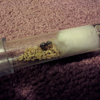I collected this Queen [and all others that will be in this Journal] during the May 2018 Nuptial Flight:
She still has wings but I'm not counting that as "in-fertile" like some would suggest. I set her up in one of my Pill Bottle test-tube like setups with a child-resistant cap [that last part is super important for me] Here's a little video I made explaining the process some-what:
And finally here's the Camponotus herculeanus queen herself:
Unfortunately due to the slow start of this species there probably won't be much updates for awhile ![]()






















